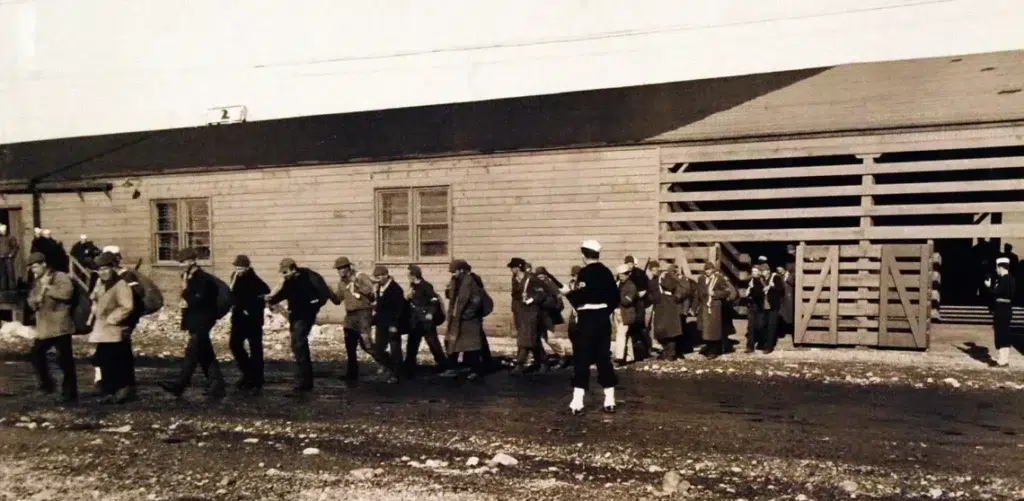Letters to Loretta: The American prisoners are marched out of the Nazi POW camp as Soviets approach
- By Kaitlin Oster
Share This Article

Editor’s Note: Sandboxx News presents a World War II series by Kaitlin Oster on the power of hope, letters, and love in seeing us through the terrors and agony of war. You can listen to Kaitlin’s radio interview about the series here or visit her website here.
Following on the coattails of the winter of 1944-1945, one of the coldest winters in Europe, the devastation of the Second World War was drawing to an inevitable close unbeknownst to the American prisoners of POW Camp Stalag XVII-B. The warming afternoons led Harold to think maybe he would finally be able to go home and see his wife. He’d have a decent meal, he thought. He’d get his teeth fixed, and put on some much-needed weight. And he’d never have to deal with a goddamn bed bug again in his life. But, Harold wondered who would come to save the men from this prison.
Food seemed to be running out, or at least was unbelievably sparse. Almost a thousand men were too ill to participate in mustering on the parade fields – no less leave – their barracks. Some prisoners voluntarily gave up their beds to accommodate the sick, which led to more men being bunked up to the remaining beds, as Harold had experienced the previous summer. He missed the summer months. He thought of the lake houses, of water skiing and fishing in Seaford with Artie. When Harold would get back home – whenever that would be – they’d have to go straight to the summer house.
Related: Letters to Loretta: A series into the power of humanity to persevere during war
Leaving the camp
The men were roused early one morning in April. The SS men were yelling at them to put on whatever shoes or gear they had available – they were leaving the camp. The men were, at first, skeptical, especially as Commandant Kuhn had stolen their gear and food only a year earlier. Some hesitated. It was cold and dark, and they were frightened that the Nazis would march them to their death.
Even in early April 1945, on some nights the men at Stalag XVII-B would find themselves in freezing temperatures; now, the SS guards and the American prisoners at XVII-B would be walking through temperatures that reached 13 below.
After learning of Russian forces steadily making their way west, the only leverage these SS had – the prisoners – were at risk.
Related: Weapons used by both sides of World War II
The sick are left behind

“Leave them.” A guard motioned to sick men in the infirmary barrack. The medic was ordered to leave. “We don’t need them coming with us; they’ll die soon anyway.”
The medic protested the inhumane treatment of the ill. That winter had left about 1,000 men too sick to function and now they were ordered to be abandoned in the camp without medical attention. The guard could not be swayed. He ordered the medic to abandon his post and march on with the rest of the soldiers.
“They’re grown men, they can look after each other. Your attention will be required on the journey, anyway.”
The men lined up and Harold stood among a crowd of cold and frightened souls as he prepared to walk forward out of the open gates of Stalag XVII-B. It all felt like a trap. He spent so many months dreaming of the day when he’d never return to that horrendous place and as it was happening before him, he couldn’t help but feel it was still a dream. He held close anything he could carry and kept craning his neck to make sure there were other men following in the same direction. They all looked unsure, but they knew they had no other choice.
The cold lingered while the fog began to lift over XVII-B, and the prisoners breathed through in heavy huffs as the hell they had endured grew smaller; the faces of the sick hung in between the barbed wire fencing like old portraits until Harold could no longer discern them.
The guards used the dogs to put the prisoners in line, left those who were too weak or ill to carry themselves, and they filed out of Stalag XVII-B for the last time.
Harold grabbed what he could and found some familiar faces to walk with. This was the beginning of the end – end of what? He didn’t know. He simply walked – marched – out of XVII-B, not knowing if he and the other men were marching to their deaths. They were all malnourished, improperly dressed, and tired. They were tired of hurting, of war, and prison. Harold knew, though, that he wasn’t tired of living.
Read more from Sandboxx News
- Did Mattel really create an M16 or is this a great urban legend?
- Back-saving exosuits may someday be standard-issue gear for troops
- The SR-72 timeline: From initial design to ‘Top Gun’s’ Darkstar
- Ukraine set off 4 explosive devices on a freight train operating on the only major railroad connecting Russia and China
- Operation Olympic Games: The first cyberweapon
Related Posts
Sandboxx News Merch
-

‘AirPower’ Classic Hoodie
$46.00 – $48.00Price range: $46.00 through $48.00 Select options This product has multiple variants. The options may be chosen on the product page -

‘Sandboxx News’ Trucker Cap
$27.00 Select options This product has multiple variants. The options may be chosen on the product page -

‘Kinetic Diplomacy’ Bumper Sticker (Black)
$8.00 Add to cart
Kaitlin Oster
Related to: Military History

New advances in submarine detection could upend nuclear deterrence as we know it
Sandboxx News
-

‘Sandboxx News’ Trucker Cap
$27.00 Select options This product has multiple variants. The options may be chosen on the product page -

‘AirPower’ Classic Hoodie
$46.00 – $48.00Price range: $46.00 through $48.00 Select options This product has multiple variants. The options may be chosen on the product page -

‘AirPower’ Golf Rope Hat
$31.00 Select options This product has multiple variants. The options may be chosen on the product page -

‘Sandboxx News’ Dad Hat
$27.00 Select options This product has multiple variants. The options may be chosen on the product page
